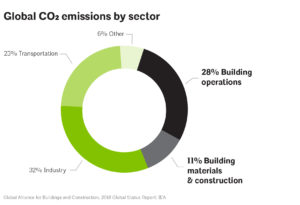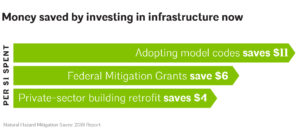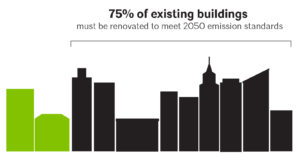
Infrastructure is the foundation of our society, and it’s both crumbling and contributing to global warming. In the wake of the election and crises like the one that recently left millions of Texans without power and water, updating the infrastructure of the United States is crucial for the country and the world. The global built environment is responsible for about 40% of annual carbon-dioxide emissions (CO2). Simultaneously, the American economy and its vertical infrastructure (including schools, civic buildings, and hospitals) need to be rebuilt.
It’s time for the government to work with architects to make a difference.

Federal investment improves the economy and the climate
Architects are key to helping the federal government make infrastructure investments that benefit our economy and the climate. In 2019, Carl Elefante, FAIA, former president of The American Institute of Architects, testified before Congress about how the built environment contributes to climate change—and how politicians can help reverse that. To meet 2050 emissions targets set by the United States, Elefante testified that at least 75% of commercial and public buildings must be renovated and retrofitted with new design strategies and technologies. To tackle a problem of that size, the federal government needs to do two things immediately. First, it needs to renovate public buildings to be carbon neutral by 2050. Second, it needs to incentivize private building owners to implement energy-efficient retrofits. This can be achieved by expanding existing tax incentives (like the Energy Efficient Commercial Buildings Deduction, 179D, and the Nonbusiness Energy Property Tax Credit, 25C) and creating new ones.
“Architects of [a previous] generation helped lead the fight for the then novel concept of mandatory fire codes,” Elefante testified. “Right now, we are at a similar inflection point when it comes to the built world … [and] partnership with business, civic, and elected leaders is the surest path to lasting success.”
Regarding new buildings, the federal government should help hasten state and municipal adoption of model building codes—standards that establish health, safety, and public-welfare protections. According to the National Institute of Building Sciences, cities that adopt model codes save $11 per $1 spent, federal mitigation grants save $6 for every $1 spent, and private-sector retrofits save $4 for every $1 spent. By working with architects to support stronger building codes, government leaders can save money, strengthen infrastructure, and help stop climate change—an increasingly important issue for national security and budgets amid intensifying natural disasters.
Architects are coming up with solutions for navigating the complexities of greener design. In February, Julie Hiromoto, AIA, a principal and the director of integration at HKS in Dallas, testified before Congress about the importance of designing a more sustainable and resilient built environment. And while she noted that the challenge ahead is significant, it shouldn’t seem daunting: Architects have been solving these kinds of issues for decades. Citing the AIA 2030 Commitment—which advocates the use of data-driven tools to improve building performance—and its alignment with the 2007 bipartisan Energy Independence and Security Act (EISA), Hiromoto explains how architects can use federal incentives to help government leaders make an impact and halt climate change.
“Architects don’t just design buildings,” she says. “We design systems that can work equitably for cities and regions. So it’s natural for us to help government leaders tackle big challenges like infrastructure, public health, security, and the environment. We apply the same design methodology, but on a larger scale.”

Federal investment and state leadership
Federal investment in infrastructure will also enhance climate leadership at the state level. In 2019, Tony Evers, the newly elected governor of Wisconsin, decided to tackle an important local issue—climate change. A Midwestern state sharply divided along political lines—Evers, a Democrat, was preceded by a Republican—Wisconsin is increasingly suffering from the effects of climate change, with warming temperatures impacting crops in the state, which is one of the largest producers of agricultural products in the U.S. After being elected, Evers created the Wisconsin Initiative on Climate Change Impacts to improve infrastructure and reduce his state’s carbon footprint, based on a set of principals used by architects—the AIA Framework for Design Excellence.
Tate Walker, AIA, the director of sustainability at OPN Architects in Madison, Wisconsin, had been using the AIA framework to help Midwestern cities assess and improve their infrastructure. Featuring 10 complementary focus areas—including economy, energy, and equitable communities—the framework is a tool for identifying opportunities to improve sustainability. It enables government leaders to select which sectors they want to prioritize and offers best practices for doing so, helping make complicated challenges more manageable. With his success using the framework to design city buildings like fire stations and schools, Walker was tapped to help Wisconsin incorporate these principles across the state’s entire portfolio of buildings, enhancing their resiliency for the future.
“Wisconsin has a long history of innovation in energy conservation in state facilities,” Walker says. “However, state leaders were looking for a more holistic way to address the design and performance of their buildings. The AIA framework works well because it’s written in plain English and accessible to a lay audience. Really, its greatest strength is that it’s just 10 things. It’s a comprehensive vision of design excellence with best practices to get there, but leaders can set their own goals to fit their projects.”

Architects offer solutions at all levels of government
Architects can help broker solutions and foster collaboration between all levels of government. In 2018, for instance, Zion National Park in Utah decided to build a new entrance on its remote east side, and planned for a simple visitor and research center. Recognizing the potential of the project, however, Helena Zambrano Macías, AIA, project architect at Overland Partners in San Antonio, Texas, worked with her colleagues to create a more ambitious goal. Collaborating with local, state, and federal officials, she designed the Applecross Station Visitor Center, a net-zero facility, powered by solar energy, with a closed-loop water system to preserve, treat, and reuse 100% of the center’s water, a precious resource in the desert.
“Architects can use our work—and buildings—to change the world,” Zambrano Macías says. “Collaborating with diverse groups, including clients, communities, and government agencies, we have numerous opportunities to advocate for a better future.”
Going forward, architects are ready to work with the federal government to rebuild the nation’s infrastructure. Doing so will facilitate progress at all levels of government, boost the economy, and help stop global warming.
Working with architects is a winning solution, and it’s time for political leaders to meet the moment.
The Blueprint for Better campaign is a call to action. AIA is asking architects, design professionals, civic leaders, and the public in every community to join our efforts. Help us transform the day-to-day practice of architecture to achieve a zero-carbon, resilient, healthy, just, and equitable built environment.